Arizona Vegetable & Fruit Gardening
For The Arizona Desert Environment
Pictures, Photos, Images
Descriptions, & Reviews.
George & Eve Delange
Arizona Soil Types
And Fertilizers To Use.

|
 |
| Raised Bed With 6 - 8 Week Old Asparagus & Corn Growing Together. Soil pH & All Other Nutrients Are Perfect. You Can See The Effects Of Proper Soil, Nutrients, Micronutrients, & Fertilizer. Proper Soil Testing Had To Be Performed On A Regular Basis. |
|---|
We Buy Our Hard To Find Fruit Trees For Yarnell Arizona At Nature Hills Nursery.
We Have Several Nice Fruit Trees Growing In Yarnell, Arizona.
They Will Do Well In Other Similar Elevations In Arizona. ie.. Prescott, Cottonwood, Camp Verde, Sedona.
Cameo & Fuji Apples! Yummm! Click The Nature Hills Nursery Link To View.



Most Arizona soils developed under desert or scrub vegetation. This factor makes Arizona Soil much different than most of the soil found in other parts of the United States. But, don't despair, there are ways to improve our soil to make it compatable with vegetable and fruit garden plants!
In the United States, soils can be classified based on a taxonomic system developed by the USDA Soil Conservation Service Soil Survey between 1951 and 1973. This system divides all soils into separate orders; it divides each order into different sub-orders, each sub-order into distinct great groups, and so forth, down into individual soil families. In the state of Arizona, you can find six of the 12 soil orders of the USDA Soil Conservation Service Soil Survey. They are called: Alfisols, Aridisols, Entisols, Inceptisols, Mollisols, & Vertisols. The other soil orders are: Andisols, Gelisols, Histosols, Oxisols, Spodosols, & Ultisols. A general description of Arizona's soil orders are:
Alfisols:
Aridisols:
Entisols:
Inceptisols:
Mollisols:
Vertisols:
We suggest that you learn which soil type or order you have or that you do a soil test with a soil test kit and make changes to the soil by fertilizer or ammendments to bring it within the requirement that you need in order to grow a particular type of vegetable in your own personal garden. We personally make sure that we test our garden soil at least on a yearly schedule, as our soil can change according to ammendments that have been added to the soil during the prior year. But, we try to test our garden soil on a weekly schedule, as our soil temperature constantly changes according to day and night time temperatures, and the times and seasons of the year. This is very important, ie... many vegetable plant seeds will not germinate until the soil temperature is at a specific temperature. We have links on this page to Amazon, where you can purchase soil testing kits. We find them to be very helpful. There are many differing opinions among garden experts concerning the merits of fertilizing with manures or other organic fertilizers versus �chemical� fertilizers. Excellent gardens can be grown using either method. Soil bacteria and fungi must act on the organic nutrient sources to change them into forms that plants can use. The major consideration in the use of organic sources is to apply the fertilizer materials far enough in advance to allow for the breakdown of the substances to ensure that an adequate supply of nutrients will be released & available when the growing plant needs it. Plants really do not differentiate between nutrients from either �organic� or �chemical� fertilizers. The forms of nutrients absorbed by plant roots from both sources of fertilizer is exactly identical. But, It should be noted that regular additions of organic materials can improve the tilth, or the state of aggregation of a soil especially in relation to its suitability for crop growth, and the water and nutrient-holding capacities of soils. In cases where predominantly organic fertilizers are used, a judicious use of supplemental chemical fertilizers will allow the gardener to take advantage of the benefits of added organic materials without compromising the availability of essential plant nutrients. Fertilizer contains many different kinds and sizes of particles, ranging from those visible to the unaided eye to particles so small that they can only be seen with the aid of a very powerful (electron) microscope. This mineral material comprises about 45% to 50% of the total volume. Organic material makes up about less then 5% of the volume and may contain both plant and animal residues in varying stages of decomposition. Under ideal or near-ideal moisture conditions for growing plants, soil pore spaces contain about 25% air and 25% water based on the total volume of soil.
The content (analysis) of most fertilizers is designated by federal law with three numbers that appear on the fertilizer package and indicate the percent nitrogen, phosphate, and potash that it contains. Examples: 15-10-5 fertilizer contains 15% nitrogen, 10% phosphate and 5% potash: 21-0-0 fertilizer contains 21% nitrogen, but no phosphate or potash. Here is the Fertilizer Nutrient Analysis of some very comon fertilizers:
Ammonium phosphate:
Ammonium sulfate:
Urea:
Triple superphosphate:
Application Methods: There are different methods of applying fertilizer depending on its formulation and the crop needs. The following terms describe the way fertilizer may be applied to a garden area.
Broadcast:
Band:
Side-dress:
Transplant Solutions:
Foliar Feeding:
Drip or Sprinkler Irrigation:
Nutrients:
Nitrogen And Phosphorus:
About 4-5 weeks after planting, some plants may begin to show a pale green or yellow color and a slower rate of growth. At this point a side-dress of 4 tablespoons (T) urea or 8 T ammonium sulfate per 10� of row should be made every two to three weeks as needed. For uniform application, dissolve fertilizer in water and apply the solution evenly with a watering can. Corn, broccoli, cauliflower, potatoes, lettuce, carrots, and beets usually require this additional nitrogen. To avoid excessive foliar growth and poor fruiting, do not apply extra nitrogen to peas, tomatoes, or squash. Over-irrigation will leach nitrogen from the root zone and may result in the need for additional side-dressings of nitrogen later in the season.
Organic Nitrogen:
Caution: Manures often contain weed seeds. Some of these weeds may be very difficult to control. In addition, feed-lot manures in particular can contain high levels of soluble salts. It may be advisable to test new sources of manure for salt content before applying it to a garden. Contact your County Extension Agent to obtain a list of agricultural laboratories operating in Arizona, which could determine the salt content of the manure. Phosphate is essential for vigorous early season growth of seedlings. It moves very slowly in the soil and best results are obtained if phosphate is banded 2� below the seed or transplant at planting. Table 1 lists some of the more common nitrogen and phosphate-containing fertilizers that are recommended for gardens in Arizona. A soil test for nitrate-nitrogen, and for phosphate, are helpful in knowing which types and what quantities of fertilizers are needed. Tests for these nutrients are normally reported as parts per million (ppm). Micronutrients:
Zinc:
Iron:
Soil Amendments:
Gypsum
Lime:
Sulfur:
Salinity:
NOTE: Applications of gypsum are not effective in reducing soil salinity.
Other Nutrients:
NOTE: If using city water as supplied to most homes in Arizona and in other states; the water contains chlorine, which is not good for plants.
NOTE: Even though we have listed the soil types found by the USDA in Arizona, because of the wide variation in elevation and climatic conditions found throughout the state there are wide differences in the types of soil profiles found. Interestingly only tropical soils are not found within Arizona. We have even found wide differences within a few feet of each other. Therefore, nothing works better in our opinion than using your own knowledge of soils and soil test kits, wherever you have a question. Here are some general comments concerning soil types and how well they may perform specifically in Arizona and some of the other places in the world. The percentage of mineral matter and organic matter in a cubic foot of surface soil varies from one soil to another, and within the same soil. Most Arizona soils have very low levels of organic matter, usually less than 1% by weight. This is due to the slow rates of organic matter production under arid conditions and the rapid rate of decomposition of organic matter when the warm soils are moistened. Content of organic matter is usually higher in soils that have not been cultivated over long periods of time. Soils that are tilled frequently or thoses with relatively small amounts of plant residues are usually lower in organic matter. Plowing and tilling the soil increases the amount of air in the soil, which increases the rate of organic matter decomposition. Soils with poor drainage or high water tables usually have a higher organic matter content than those which are well drained, because water excludes air from the soil mass. Regarding water or air in the soil, since pore spaces are filled with either air or water, the amount of air in a soil at a particular time depends on the amount of water present in the pore spaces. Immediately after a rain, there is more water and less air in the pore spaces. Conversely, in dry periods, a soil contains more air and less water. Increasing organic matter content usually increases water-holding capacity, but adding undecomposed organic material reduces water capacity until the material has partially decomposed. Most soils everywhere, generally speaking, have two or more distinct soil layers or sometimes called horizons. The principal soil layers or horizons (collectively called the soil profile) are: A, surface soil; E, the subsurface; and B, the subsoil. Beneath the soil profile lies: C, the parent material; and R, rock, which may be similar to that from which the soil developed. Many of the soils in Arizona have developed in 1. water-deposited (alluvium), 2. wind- deposited (aeolian silt or sand), or 3. gravity transported materials (colluvium). Whenever soil horizons are present , they usually differ from one another in 1. color, 2. texture, 3. consistency, and 4. structure. In addition, there are usually several considerable differences in chemical characteristics or composition. The surface and subsurface soils are usually the coarsest layers. The surface soil contains more organic matter than the other soil layers. Organic matter gives a gray, dark-brown, or black color to the surface horizon, the color imparted depending largely upon the amount of organic matter present. NOTE: Soils that are highest in organic matter usually have the darkest surface colors. The surface layer is usually most fertile and has the greatest concentration of plant roots; plants obtain much of their nutrients and water from the surface soil. This is the soil layer that almost all gardens are in. Any human activity which removes or degrades the surface soils is very serious considering the relatively higher quality of this horizon. The subsoil layer is usually finer and firmer than the surface soil. Organic matter content of the subsoil is usually much lower than that of the surface layer. The subsoil supports the surface soil and may be considered the soil reservoir, providing storage space for water and nutrients for plants, aiding in temperature regulation of the soil, and supplying air for the roots of plants. But, the subsoil can also present serious problems for those wanting to use the soil to grow plants. These include coarse sandy or gravelly layers, hardpans or caliche layers. "Caliche" is a specific type of naturally occurring hardpan layer up to six feet thick which is cemented with calcium carbonate. NOTE: In Arizona, caliche is found sometimes just a few inches below the surface soil, making it almost impossible to grow a lawn or garden. That is one of the main reasons that "Raised Gardens" are recommended for Arizona Gardening. If you are planting a tree, you MUST break through the Caliche and fill in the hole with your tree and good soil ammendments, so that the roots can grow in soil. Otherwise, your tree will not have root support and it will most likely blow over during our next monsoon season. Just drive through a few of the newer neighborhoods in Arizona after a monsoon storm and you will see numerous trees blown over because they were not planted properly. Also, the subsoil coarse sandy or gravel layers are sometimes very dry and may not supply adequate moisture for your growing plant roots. The bottom horizon, or parent material, is usually decomposed rock or other transported material that has acquired some characteristics of the subsoil and retained some characteristics of the rock or other geological material from which it weathered. It is not hard, like rock, but may show the form or structure of the original rocks or layering if it is in a water-laid deposit. The parent material influences soil texture, natural fertility, rate of decomposition (and thus rate of soil formation), alkalinity, depth, and in some cases, topography (or lay of the land) on which the soil is formed. NOTE: Once more, we suggest that you learn which soil type or order you have or that you do a soil test with a soil test kit and make changes to the soil by fertilizer or ammendments to bring it within the requirement that you need in order to grow a particular type of vegetable in your own personal garden.
Also, during the growing seasons, we personally try to test our garden soil on a weekly schedule, as our soil temperature and other conditions, constantly changes according to day and night time temperatures, and the times and seasons of the year. This is very important, ie... many vegetable plant seeds will not germinate until the soil temperature is at a specific temperature.
Quick Down & Dirty Summary For Clay Soils:
Note: If your topsoil has a lot of clay in it, add sand to your soil mixture. Here is a good rule of thumb guide to use. We spade up the existing soil as deeply as we can. Then for every ten square feet of bed we pour on a two cubic foot bag of soil conditioner . On top of this we add two bags of General Purpose Sand (available at home improvement stores). If we have not already done so, we also scatter a pint of garden lime and about a half-bag of hen manure on the ten square foot site. We use shovels to mix it all together and then we use a hoe & rake to make it level. We finish the job by raking the bed smooth, before watering it and placing seeds or plants into the soil. We have a new page about the cultivation and tilling of soil in Arizona for commerical growers that can be of interest to gardeners in Arizona. We can see on that page how commercial methods could be modified for Home Gardening. It is: Arizona Soil Tilling, & Cultivation..
Another great resource about soil preparation for Arizona is the Guidelines for Head Lettuce Production in Arizona. Cooperative Extension, College of Agriculture and Life Sciences, University of Arizona, Tucson, Arizona.
|
 |
| Raised Bed With 6 - 8 Week Old Asparagus & Corn Growing Together. Soil pH & All Other Nutrients Are Perfect. You Can See The Effects Of Proper Soil, Nutrients, Micronutrients, & Fertilizer. Proper Soil Testing Had To Be Performed On A Regular Basis. |
|---|
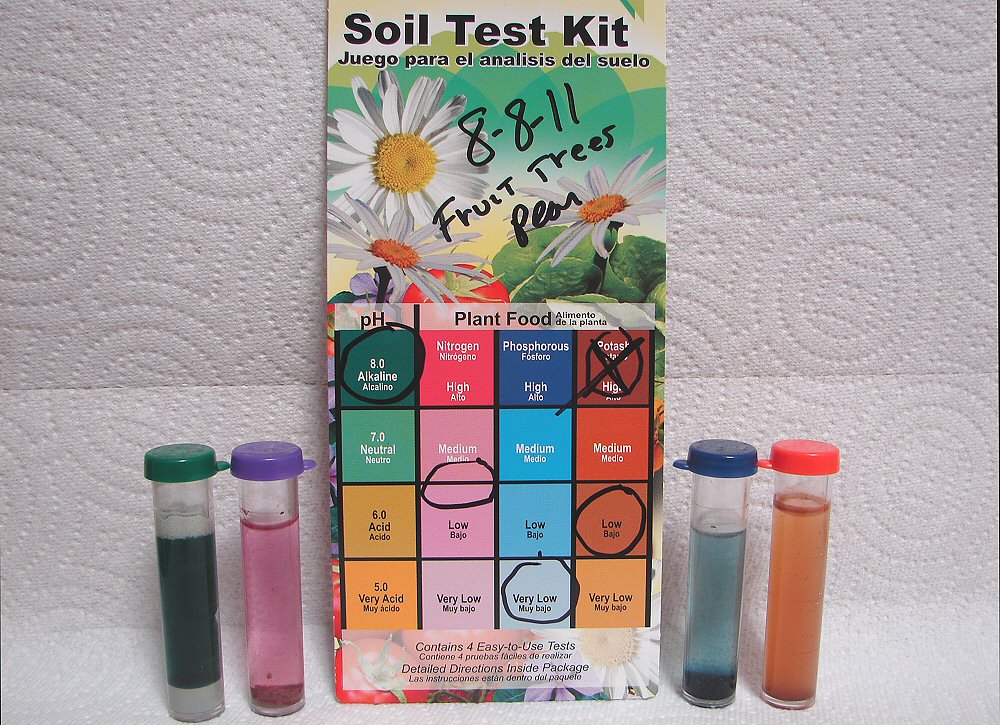 |
| Soil Test Showing Typical Central & Southwestern Arizona Soil Conditions. Highly Alkaline or High pH. Usually Little or No Nitrogen, Phosphorus, and Potassium (or Potash). This Test Was Taken Two Years After The Soil Had Been Corrected. So Soil Correction Is An Ongoing Activity In Arizona Gardening. Arizona Vegetable & Fruit Gardening For The Arizona Desert Environment. |
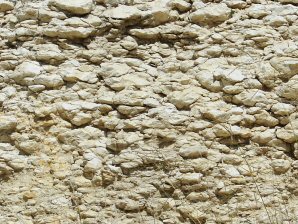 |
| Caliche The Cause Of Numerous Failures Of Gardens, Orchards, & Landscapings. It Often Lurks Inches or Feet Beneath Your Lawn, Garden, or Orchard! Very Common In Arizona Soil! |
|---|
The Images Shown Below, Are In Order, According To
How You Would Work The Sand Into The Clay Soil.

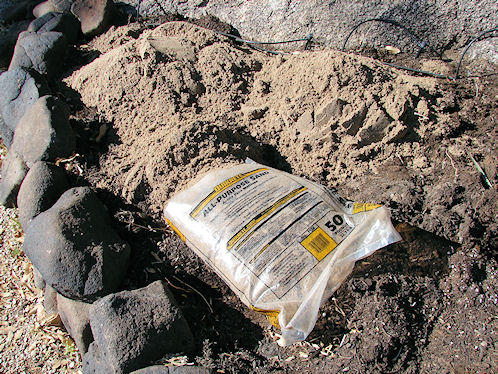
Use General Purpose Sand. Add General Purpose Sand To Tilled Clay Soil. 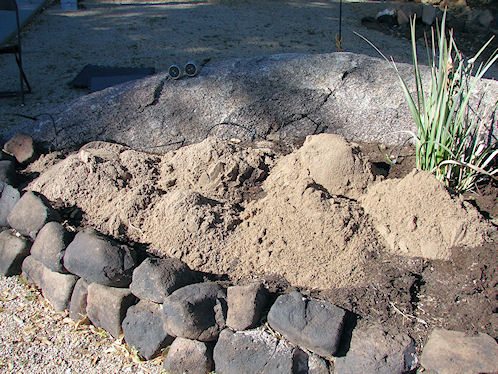
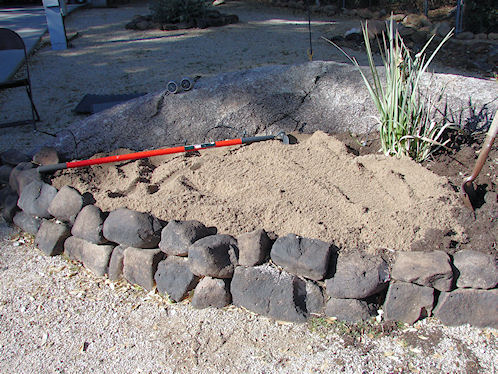
Pour General Purpose Sand On The Clay. Evenly Spread The Sand On The Clay. 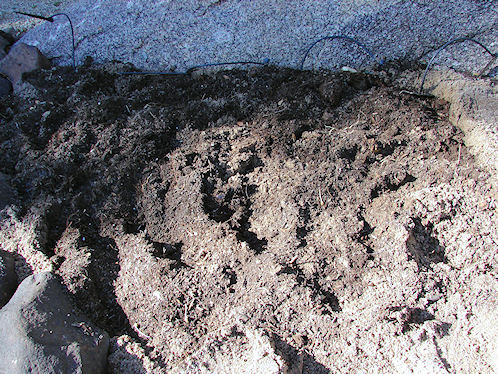
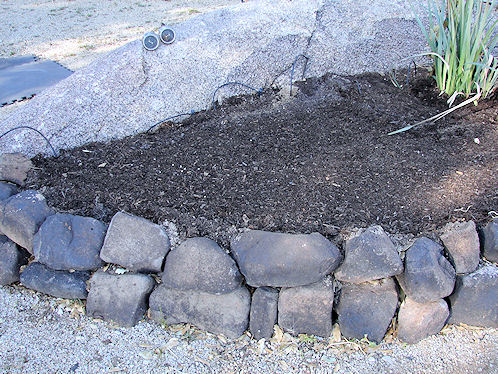
Evenly Spade The Sand Into The Clay. Evenly Rake The Soil To Level It. 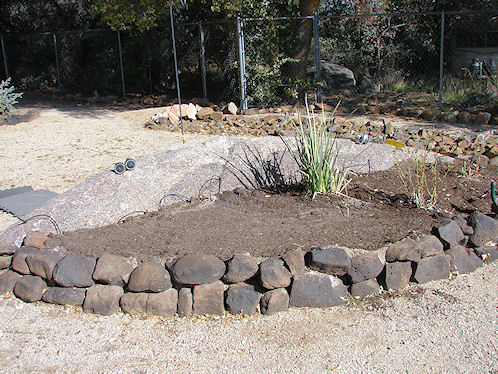
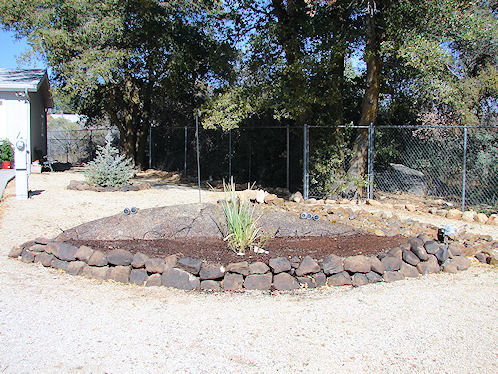
Half Way Finished. All Done!
Click Here To See The University of Maine Cooperative Extension
Publication About Fertilizer. You Will Leave deLange.org
We Are Proud Of Our SafeSurf Rating!
Below Are Ads For Soil Test Meters & Kits
Sold Through Amazon.Com That We Recommend,
Click On The Item For A More Detailed Look. No Obligation!
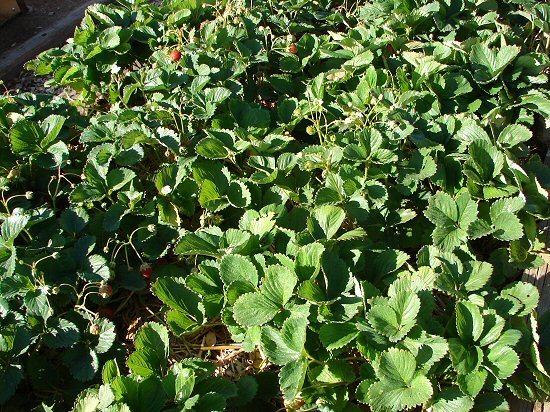
Raised Bed With 8 Week Old Strawberries.
Soil pH & All Other Nutrients Are Perfect.
You Can See The Effects Of Proper Soil,
Nutrients, Micronutrients, & Fertilizer.
Proper Soil Testing
Had To Be Performed On A Regular Basis.
We Buy Our Hard To Find Fruit Trees For Yarnell Arizona At Nature Hills Nursery.
We Have Several Nice Fruit Trees Growing In Yarnell, Arizona.
They Will Do Well In Other Similar Elevations In Arizona. ie.. Prescott, Cottonwood, Camp Verde, Sedona.
Cameo & Fuji Apples! Yummm! Click The Nature Hills Nursery Link To View.



Click Here To See Free Arizona Sonoran Desert Plants Native Food Recipes.
© 1966 - Present, George & Eve DeLange
We're Glad You Stopped By! Come back soon!
All Of Our Images Are Copyrighted. They May Not Be Used Without Permission.
The Low Resolution Photos That Can Be Downloaded From Our Pages Are Available, Free Of Charge, Upon Request:
To Students, & Teachers For Classroom Use
Any Other Use Is Considered Commercial.
Almost All Of Our Photos (NOT ALL) Are Available In High Resolution, For Commercial Use (Books, Magazines, TV Productions, etc.)
They Are Royalty Free, And A One Time, $30 US Fee Is Charged For Each Photo
We Are Proud Of Our SafeSurf Rating!
 |  |
| Use General Purpose Sand. | Add General Purpose Sand To Tilled Clay Soil. |
|---|---|
 |  |
| Pour General Purpose Sand On The Clay. | Evenly Spread The Sand On The Clay. |
 |  |
| Evenly Spade The Sand Into The Clay. | Evenly Rake The Soil To Level It. |
 |  |
| Half Way Finished. | All Done! |
Publication About Fertilizer. You Will Leave deLange.org
We Are Proud Of Our SafeSurf Rating!
Sold Through Amazon.Com That We Recommend,
Click On The Item For A More Detailed Look. No Obligation!
 |
| Raised Bed With 8 Week Old Strawberries. Soil pH & All Other Nutrients Are Perfect. You Can See The Effects Of Proper Soil, Nutrients, Micronutrients, & Fertilizer. Proper Soil Testing Had To Be Performed On A Regular Basis. |
|---|
We Buy Our Hard To Find Fruit Trees For Yarnell Arizona At Nature Hills Nursery.
We Have Several Nice Fruit Trees Growing In Yarnell, Arizona.
They Will Do Well In Other Similar Elevations In Arizona. ie.. Prescott, Cottonwood, Camp Verde, Sedona.
Cameo & Fuji Apples! Yummm! Click The Nature Hills Nursery Link To View.



| © 1966 - Present, George & Eve DeLange |
We're Glad You Stopped By! Come back soon!
All Of Our Images Are Copyrighted. They May Not Be Used Without Permission.
The Low Resolution Photos That Can Be Downloaded From Our Pages Are Available, Free Of Charge, Upon Request:
To Students, & Teachers For Classroom Use
Any Other Use Is Considered Commercial.
Almost All Of Our Photos (NOT ALL) Are Available In High Resolution, For Commercial Use (Books, Magazines, TV Productions, etc.)
They Are Royalty Free, And A One Time, $30 US Fee Is Charged For Each Photo
We Are Proud Of Our SafeSurf Rating!





